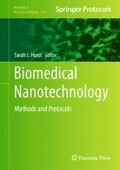Abstract
Some efficient diagnosis and therapy systems require the isolation and quantification of circulating tumor cells (CTCs), since these species are important “biomarkers” for monitoring cancer metastasis and prognosis. Existing techniques for isolating/counting CTCs include immunomagnetic-bead-based separation and microfluidic capture. However, some of these techniques have low capture efficiency and low specificity. Through the use of a three-dimensional (3D) nanostructured substrate – specifically, a silicon-nanowire (SiNW) array coated with epithelial-cell-adhesion-molecule antibodies (anti-EpCAM) – we show that CTCs can be captured efficiently and specifically. Unlike conventional methods for isolating CTCs that depend on collision frequency and contact duration, nanoscaled local topographic interactions between the CTCs and the substrate increase their binding and markedly enhance capture efficiency.
Access this chapter
Tax calculation will be finalised at checkout
Purchases are for personal use only
References
Steeg, P. S. (2006) Tumor metastasis: mechanistic insights and clinical challenges. Nat. Med. 12, 895–904.
Bernards, R. and Weinberg, R. A. (2002) A progression puzzle. Nature 418, 823.
Pantel, K. and Brakenhoff, R. H. (2004) Dissecting the metastatic cascade. Nat. Rev. Cancer 4, 448–56.
Budd, G. T., Cristofanilli, M., Ellis, M. J., Stopeck, A., Borden, E., Miller, M. C., et al. (2006) Circulating tumor cells versus imaging--predicting overall survival in metastatic breast cancer. Clin. Cancer Res. 12, 6403–6409.
Allard, W. J., Matera, J., Miller, M. C., Repollet, M., Connelly, M. C., Rao, C., et al. (2004) Tumor cells circulate in the peripheral blood of all major carcinomas but not in healthy subjects or patients with nonmalignant diseases. Clin. Cancer Res. 10, 6897–6904.
Zieglschmid, V., Hollmann, C., and Böcher, O. (2005) Detection of disseminated tumor cells in peripheral blood. Crit. Rev. Clin. Lab. Sci. 42, 155–196.
Pantel, K., Brakenhoff, R. H., and Brandt, B. (2008) Detection, clinical relevance and specific biological properties of disseminating tumour cells. Nat. Rev. Cancer 8, 329–340.
Cristofanilli, M., Budd, G. T., Ellis, M. J., Stopeck, A., Matera, J., Miller, M. C., et al. (2004) Circulating tumor cells, disease progression, and survival in metastatic breast cancer. New Engl. J. Med. 351, 781–791.
Talasaz, A. H., Powell, A. A., Huber, D. E., Berbee, J. G., Roh, K.-H, Yu, W., et al. (2009) Isolating highly enriched populations of circulating epithelial cells and other rare cells from blood using a magnetic sweeper device. Proc. Natl. Acad. Sci. USA 106, 3970–3975.
Allan, A. L., Vantyghem, S. A., Tuck, A. B., Chambers, A. F. Chin-Yee, I. H., and Keeney, M. (2005) Detection and quantification of circulating tumor cells in mouse models of human breast cancer using immunomagnetic enrichment and multiparameter flow cytometry. Cytometry A 65, 4–14.
Nagrath, S., Sequist, L. V., Maheswaran, S., Bell, D. W., Irimia, D., Ulkus, L., et al. (2007) Isolation of rare circulating tumour cells in cancer patients by microchip technology. Nature 450, 1235–1239.
Adams, A. A., Okagbare, P. I., Feng, J., Hupert, M. L., Patterson, D., Gottert, J., et al. (2008) Highly efficient circulating tumor cell isolation from whole blood and label-free enumeration using polymer-based microfluidics with an integrated conductivity sensor. J. Am. Chem. Soc. 130, 8633–8641.
Wang, S., Wang, H., Jiao, J., Chen, K.-J., Owens, G. E., Kamei, K.-I., et al. (2009) Three-dimensional nanostructured substrates toward efficient capture of circulating tumor cells. Angew. Chem. Int. Ed. 48, 8970–8973.
Acknowledgments
The authors appreciate the helpful discussions with Dr. Hao Wang, Dr. Jing Jiao, Dr. Ken-ichiro Kamei, Dr. Jing Sun, Kuan-Ju Chen, Gwen E. Owens, and David J. Sherman. This research was supported by NIH-NCI NanoSystems Biology Cancer Center (U54CA119347).
Author information
Authors and Affiliations
Corresponding author
Editor information
Editors and Affiliations
Rights and permissions
Copyright information
© 2011 Springer Science+Business Media, LLC
About this protocol
Cite this protocol
Wang, S., Owens, G.E., Tseng, HR. (2011). Nano “Fly Paper” Technology for the Capture of Circulating Tumor Cells. In: Hurst, S. (eds) Biomedical Nanotechnology. Methods in Molecular Biology, vol 726. Humana Press. https://doi.org/10.1007/978-1-61779-052-2_10
Download citation
DOI: https://doi.org/10.1007/978-1-61779-052-2_10
Published:
Publisher Name: Humana Press
Print ISBN: 978-1-61779-051-5
Online ISBN: 978-1-61779-052-2
eBook Packages: Springer Protocols

